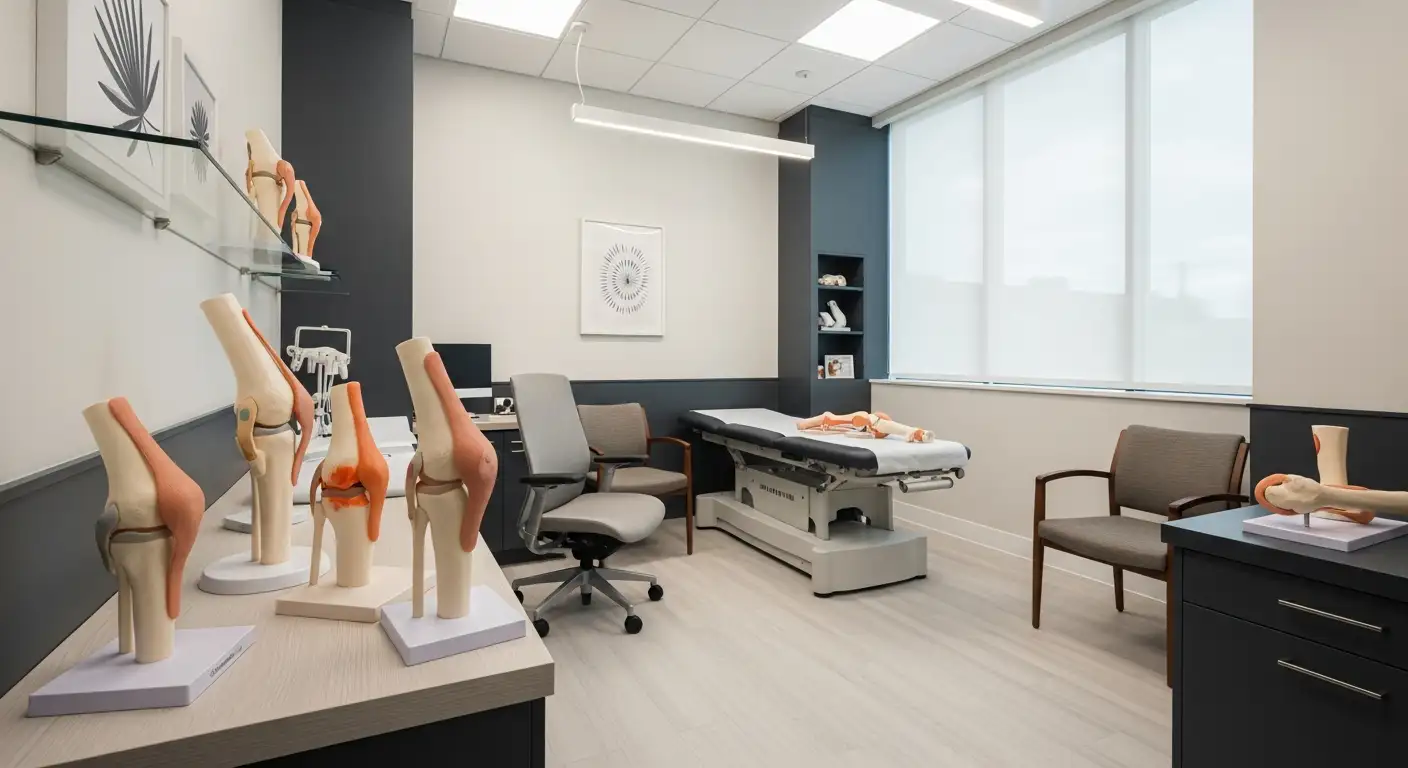Exploring the Frontiers of Pain Management
As chronic knee pain continues to affect millions worldwide, advancements in medical technology strive to offer effective, minimally invasive treatment options. Genicular Artery Embolization (GAE) is a recent development in managing pain associated with knee osteoarthritis (OA). This technique provides new avenues for patients who have not found relief through conventional means. With its promising results and ongoing research, GAE is quickly becoming a topic of interest in the world of interventional radiology and pain management.
Unpacking Genicular Artery Embolization

What is genicular artery embolization, and how does it compare to traditional treatment methods?
Genicular artery embolization (GAE) is a minimally invasive procedure designed to alleviate chronic knee pain, primarily from osteoarthritis (OA), by obstructing blood supply to inflamed areas of the synovium. This targets the underlying causes of inflammation and pain by selectively embolizing the genicular arteries. GAE can significantly reduce inflammation and improve patients' quality of life, with studies indicating a pain reduction of around 50 mm on the Visual Analog Scale (VAS) after just one month following the procedure.
GAE stands out from traditional treatments such as physical therapy and pain medications. While these methods primarily focus on enhancing strength and function, they often require numerous sessions and may only provide short-term relief. In contrast, GAE has been reported to produce longer-lasting effects, with many patients experiencing relief for up to two years. This makes GAE particularly advantageous for patients who have not seen satisfactory results from conservative treatments or are unsuitable for more invasive surgeries like total knee arthroplasty.
| Aspect | Genicular Artery Embolization (GAE) | Traditional Treatment Methods |
|---|---|---|
| Procedure Type | Minimally invasive | Varies (e.g., physical therapy, medications) |
| Duration of Relief | Up to 2 years | Short-term (variable effectiveness) |
| Target | Specific inflamed areas | General knee strength and function |
| Recovery Time | Outpatient with minimal downtime | Varies (longer recovery often needed) |
| Patient Suitability | Ideal for those unresponsive to conservative methods | Broad, assumes general mobility and function |
In summary, GAE offers a promising alternative for effective knee pain management, especially for patients battling osteoarthritis when traditional methods fall short.
Recent Developments in GAE Technology

What are the latest developments in genicular artery embolization?
Recent advancements in genicular artery embolization (GAE) have solidified its position as an effective procedure for alleviating knee pain due to osteoarthritis (OA). GAE is particularly beneficial for patients who have not found relief through conservative treatments. Early clinical evidence indicates patients experience substantial pain relief, often reporting significant improvements in functionality within the first three months post-procedure. Clinical success rates, with respect to pain reduction, hover around 60% within one year.
Ongoing trials like the GENESIS 2 and GAUCHO studies are critically assessing GAE's effectiveness compared to placebo and other existing treatments. Notably, these trials aim to demonstrate GAE's potential to reduce the need for analgesics and anti-inflammatory medications, showcasing its impact on patients' overall treatment approaches.
Efficacy and safety advancements
The growing body of research around GAE highlights its safety profile, with only mild to moderate side effects reported, primarily related to temporary discomfort or procedural pain. The technical success rates of GAE remain impressively high, nearing 100%, reinforcing its reliability as a minimally invasive option for knee pain management. The incorporation of advanced imaging techniques and refined embolic materials has further enhanced the precision and outcomes of the procedure, leading to increased patient satisfaction and quality of life improvements.
Overall, the continued evolution of GAE technology and the promising results from ongoing clinical trials underline its role as a vital option for individuals struggling with knee pain from osteoarthritis.
Evolution and Current Research on GAE
How long has genicular artery embolization been used and what is the current status of research?
Genicular artery embolization (GAE) has been explored as a treatment for knee osteoarthritis for approximately eight years. During this time, it has gained attention for its potential to alleviate chronic knee pain by effectively reducing inflammation through targeted embolization of specific blood vessels.
Current studies suggest that GAE can provide significant pain relief and functional improvement, especially in patients with mild to moderate osteoarthritis. Notably, preliminary findings indicate a remarkable technical success rate nearing 100%.
However, most of the existing research consists of noncontrolled cohort studies. Promisingly, two randomized, sham-controlled trials have been conducted, which demonstrate that complete embolization can yield benefits surpassing placebo effects.
What are the comparisons with placebo effects?
Outcomes from these trials indicate a clinical success rate of approximately 60% one year after the procedure, as evaluated by established metrics like the Western Ontario and McMaster Universities Osteoarthritis Index (WOMAC) and the Knee Injury and Osteoarthritis Outcome Score (KOOS).
To further enhance treatment outcomes, ongoing trials like the GAUCHO trial are underway, focusing on the assessment and comparison of various embolic agents. This continuing research aims to consolidate GAE's role as an effective therapy for patients struggling with refractory knee osteoarthritis, establishing it as a promising alternative to more invasive surgical options.
Comparing GAE to Genicular Nerve Block
What are the advantages of genicular artery embolization over genicular nerve block for knee osteoarthritis?
Genicular artery embolization (GAE) offers several advantages over genicular nerve blocks (GNB) for knee osteoarthritis treatment. GNB may provide temporary relief by blocking pain signals near the genicular nerves, but its effects typically last only a few weeks or months, necessitating repeated interventions for sustained pain management.
In contrast, GAE targets the arteries supplying blood to inflamed areas of the knee, addressing the underlying causes of pain and inflammation. This can lead to prolonged relief, with many patients experiencing benefits lasting from several months up to two years after a single procedure.
Moreover, GAE can significantly improve overall mobility by reducing inflammation in addition to pain relief, while GNB primarily alleviates pain without addressing inflammatory processes. These factors suggest that GAE presents a more effective long-term treatment option for patients suffering from knee osteoarthritis.
Potential Risks of GAE

What are the potential disadvantages and side effects of genicular artery embolization?
Genicular artery embolization (GAE) offers a promising approach for chronic knee pain relief, particularly for those with osteoarthritis. However, it is important to recognize the potential risks associated with the procedure. The most common side effects include:
- Non-target embolization: This can occur when particles intended for the genicular arteries inadvertently block other vessels. It may result in temporary skin discoloration in 10-65% of patients.
- Puncture site complications: Hematomas or bruising around the incision site may affect 10-17% of individuals, albeit usually resolving without intervention.
- Rare adverse effects: Some patients may experience tingling sensations or unusual nerve reactions, as well as potential damage to surrounding tissues.
While GAE's overall safety profile is considered favorable, patients should be thoroughly informed about these possible side effects, ensuring they weigh the benefits against these risks before proceeding.
Future Directions of GAE Technology

Impact of Innovations in Procedure
As Genicular Artery Embolization (GAE) continues to develop, innovative techniques are being explored to enhance procedural efficacy and patient outcomes. Recent advancements in imaging technologies, such as improved MRI and angiography, allow for more precise targeting of abnormal blood vessels in the knee. Furthermore, the introduction of new types of embolic agents, including bioresorbable particles and drug-eluting embolics, opens avenues for minimizing complications and optimizing pain relief.
In addition, robotic-assisted approaches are being investigated to increase precision during the embolization process, potentially reducing procedure times and improving the overall safety profile of the intervention. Such innovations aim to bolster the technical and clinical success rates of GAE, which currently range from 84% to 100%.
Potential Applications in Broader Medical Fields
While GAE was initially developed for osteoarthritis, emerging studies indicate its potential for treating other knee-related conditions, such as rheumatoid arthritis and post-traumatic arthritis. Its ability to target neovascularization and inflammation suggests that this minimally invasive procedure may benefit a wider range of patients with varying knee pathologies.
The ongoing evaluation of GAE might lead to applications beyond orthopedic treatments. Exploring its utility in other inflammatory joint diseases could greatly expand the impact of GAE in the medical community, offering newer treatment alternatives for chronic pain syndromes.
The Path Forward for Genicular Artery Embolization
As the medical community continues to explore less invasive approaches to treat knee pain, genicular artery embolization emerges as a powerful tool in the arsenal against knee osteoarthritis. Its technological advancements and promising outcomes reflect a treatment option poised to offer lasting relief when traditional methods fall short. With ongoing trials and research leading the charge, GAE represents not only a hopeful solution for today's sufferers but also a beacon of innovation in future orthopedic care. The continuing commitment to addressing both the efficacy and safety of GAE will be instrumental in shaping its place in clinical practice, offering patients an improved quality of life and renewed hope for pain-free living.
References
- The Promise of Genicular Artery Embolization
- Genicular Artery Embolization: A New Tool for the Management of ...
- Genicular Artery Embolization: A Practical Guide for Interventional ...
- Unveiling a Game Changer in Osteoarthritis of the Knee: Genicular ...
- Genicular Artery Embolization: A Breakthrough Treatment for Knee ...
- Selective Genicular Artery Embolization in the Management of ...
- Genicular Artery Embolization: Building Evidence and Practice
- Genicular Artery Embolization Technique: A Comprehensive Insight
- The Role of Geniculate Artery Embolization to Treat Knee ...





